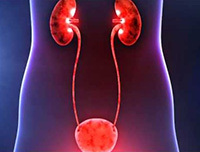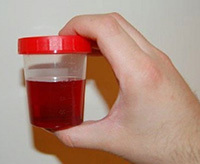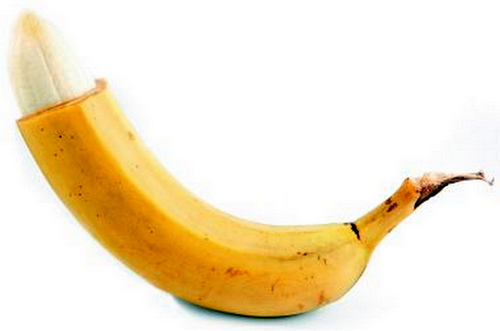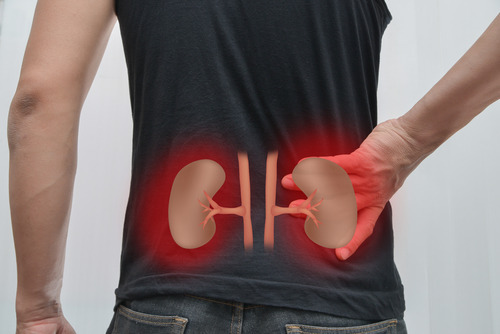Signs and treatment of pyelonephritis in men
Pyelonephritis is an inflammation of the renal tubular system. Purulent-inflammatory damage of the cup-and-pelvic system is caused by the mucosal lesions of bacterial agents. Pyelonephritis is much more common in women due to anatomical and functional features of the urinary and urinary tract. Unlike the male urethra, the female is shorter than more than twice and has a predominantly straight form, which facilitates an easier penetration of the infection from the external environment into the genito-urinary tract.
However, it is not possible to exclude the appearance of the disease in men, despite the beneficial structure of the genito-urinary organs. Complex predisposing factors lead to the occurrence of pyelonephritis.
Content
- 1 Predisposing factors and causes
- 2 disease forms
- 3 clinical picture and symptoms
- 4 Diagnosis
- 4.1 Laboratory Methods
- 4.2 Instrumental research methods
- 5 Medical tactic
- 5.1 Conservative therapy
- 5.2 Diet
- 5.3 Surgery
- 6 Prevention
Predisposing factors and causes of
Factors. As factors contributing to pyelonephritis in men, may act:
- age over 50 years;
- inflammatory diseases of the prostate;
- disturbance of metabolic processes;
- urolithiasis;
- reduced immunity.

Urinary tract infections are the main cause of pyelonephritis.
Reasons. The presence of pathogenic bacterial flora in the genitourinary tract leads to the development of pyelonephritis. Most often, with pyelonephritis, bacteria of the genus Esherichia Koli( colibacillus), staphylococcus and ehnetrococcus are sown. These bacteria cause damage to the internal membrane of the capillary system, the mucosa, and lead to the formation of purulent-inflammatory masses with violation of urodynamics. As a result of reflux of urine, the bacteria retrograde fall into the ureters and settle in the bowl-pelvic apparatus.
Pyelonephritis is a complex disease, the treatment of which requires an integrated approach. Often acute pyelonephritis passes into a chronic form, which is more difficult to treat conservatively and can lead to the formation of chronic renal failure.
Forms of the disease
The pyelonephritis can be classified according to various signs, including: the onset of the disease, the localization of the pathological process, the phase of the disease, the activity of the process and the clinical form.
Pyelonephritis is primary and secondary .
- Primary pyelonephritis occurs extremely rarely and is not accompanied by a violation of urodynamics.
- Secondary pyelonephritis occurs when bacteria enter the urinary system and urodynamic disturbances. The most common cause of secondary pyelonephritis is kidney stones.
According to the clinical course, pyelonephritis is commonly divided into acute and chronic .
- In acute form, the clinical picture is clearly expressed, with the kidney significantly increasing in size, its capsule is stretched due to edema. Often acute pyelonephritis proceeds in purulent form and is accompanied by general intoxication of the body, chills, fever, and pain syndrome.
- In chronic form, the clinic is not as pronounced or even absent, but the inflammatory process still remains. The chronic form of pyelonephritis often leads to the formation of chronic renal failure, which slowly progresses.
Clinical picture and symptoms
External signs. Pyelonephritis is characterized by the presence of certain symptoms, which include:
-

Fever, chills indicate an acute process with pyelonephritis.
Fever. High febrile temperature up to 39 ° C arises abruptly and lasts for a long time. Such a fever is accompanied by a strong chill, significant sweating. High temperature figures are characteristic of the acute form of pyelonephritis.
- Intoxication is manifested by severe weakness, dizziness, headaches, nausea and even vomiting. The intoxication syndrome, as well as the fever, is characteristic of the acute form.
- Pain syndrome. In the case of pyelonephritis, the pain sensations are aching and pulling, and are localized mainly in the lumbar region. Sometimes there may be so-called "shooting" pain along the ureters, during their spasms.
In the absence of timely and rational treatment of acute pyelonephritis, the clinical picture varies somewhat. Symptoms of fever and intoxication subside, painful sensations become dull, but do not go completely. Subfebrile body temperature may persist.
Indicators of laboratory analysis. Separately it is necessary to tell about a picture of the general analysis of a blood and the general analysis of urine in which the significant increase of leucocytes is defined. Especially pronounced leukocytosis is observed in the acute phase of the disease. Leukocytosis is accompanied by a shift of the leukocyte formula to the left, which indicates the presence of a purulent-inflammatory process in the kidneys. In the general analysis of urine, a large number of leukocytes and bacteria are detected in the field of vision, there may be fresh erythrocytes and mucus.
Diagnostic studies of
When a man contacts a urologist for advice and if there is a suspicion of pyelonephritis, the doctor directs the patient to a standard examination set. The diagnostic complex includes laboratory and instrumental diagnostic methods.
Laboratory research methods
Studies are mandatory with the definition:
- of a general blood test;
- biochemical composition of blood;
- the general or common analysis of urine.
It is necessary to determine ESR - the rate of erythrocyte sedimentation. Bacteriological examination is mandatory. It includes the inoculation of urine on nutrient media with the determination of pathogenic microflora and sensitivity to antibiotics, as well as bacterioscopy. In some cases, laboratory diagnostics are supplemented with Zemnitsky's assay, which helps determine the concentration ability of the kidneys.

With pyelonephritis, urine can take a shade of meat slops.
In a general blood test, the patient is determined by varying degrees of leukocytosis and an increase in the rate of erythrocyte sedimentation. In biochemical analysis, the increase in the amount of urea and creatinine is determined, as a result of the fact that the glomerular apparatus loses its functionality and the metabolic products are less readily excreted from the body.
In the general analysis of urine, a large amount of mucus, suspended matter is determined. Visually urine acquires a color of meat slops with a murky color. When microscopy is determined by a large number of leukocytes, bacteria, as well as cells of the cylindrical epithelium of the renal tubules.
Read on: Urine color - norm and pathology
Instrumental research methods
Such techniques include ultrasound diagnosis of pelvic organs and retroperitoneal space( kidneys).When performing ultrasound, you can identify the size of the affected kidney, the degree of infectious and inflammatory process.
In addition to ultrasound diagnosis, it is often necessary to perform excretory urography, which allows to determine the degree of disturbance of urodynamics.
In rare cases, radionuclide research methods are used that allow the body parenchyma visually to be displayed.
Therapeutic tactics
The main directions in the treatment of pyelonephritis in men can be divided into three major and radically different directions:
- conservative treatment;
- surgical treatment;
- diet therapy.
There are also some features in the treatment of patients with acute and chronic form of pyelonephritis.
Conservative therapy
Treatment of any form of pyelonephritis begins with antibiotic therapy. In the best case, the antibiotic is selected individually for each patient, after determining the bacteriological study for the sensitivity of the pathogen to antibiotics. However, antibiotics are beginning to be applied before the results of sowing on nutrient media, since the treatment of pyelonephritis does not require urgent.
Diet

Antibiotic therapy is the first and main method of treatment of pyelonephritis.
Conservative therapy of any form of pyelonephritis should necessarily be supplemented with diet therapy, to discharge the urinary system and maintain immunity.
The main rules of nutrition for pyelonephritis include the exclusion of salted and fried foods, i.e. the general sparing of the body and kidneys in particular. It is necessary to apply renal dues. Specialized diet with pyelonephritis corresponds to diet number 7 , while the consumption of salty foods and protein is limited.
Read also: How to maintain kidney health: important recommendations for the paired body
Surgical treatment
Surgical treatment of pyelonephritis is used in extreme cases: with severe forms and a high risk of serious complications. Surgery is very rarely performed in the acute form of pyelonephritis, and the aim of such intervention is to create an outflow pathway for purulent masses.
Among the most common surgical interventions for pyelonephritis, we can distinguish:
- kidney decapsulation;
- pyelostomy;
- nephroprilostomy is the creation of an outflow from the cup-and-pelvis system directly to the skin.
In purulent-destructive processes, nephrectomy is used, that is, removal of the destroyed kidney to avoid the development of retroperitoneal phlegmon.
Prevention
Preventive measures aimed at inhibiting the occurrence of pyelonephritis in men are reduced to careful monitoring of pathogenic factors that increase the risk of pyelonephritis. Only the exclusion of these factors can help to protect yourself from the onset of pyelonephritis.
It is charming to lead a healthy and active lifestyle, and also to adhere to personal intimate hygiene. It is necessary to refrain from unsafe and one-time sexual relations, and also it is necessary to monitor the maintenance of immunity. Often, pyelonephritis occurs against a weakened immune system.
Recommended for viewing:



